The Influence of Japanese Art on Surf Culture
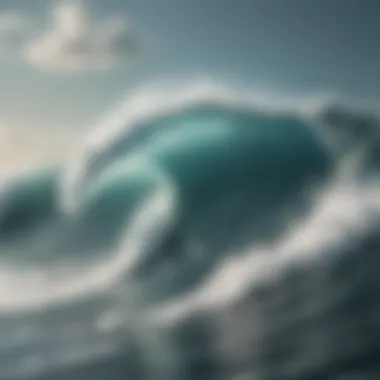

Intro
The connection between art and nature has long been a subject of admiration, yet few cultures embody this interplay quite like Japan. The dramatic coastline of the Land of the Rising Sun is not just a backdrop but an integral part of its art and identity. This deep reverence for the ocean can be seen vividly in traditional Japanese art forms, especially the renowned Great Wave off Kanagawa by Katsushika Hokusai. The aesthetic quality found in such pieces does more than please the eye; it echoes the heart and soul of surf culture. Today, the visual language of those Japanese waves impacts the surfing community, influencing everything from surfboard design to the very philosophy behind riding the waves.
By examining this unique fusion of ancient art and modern sport, one can gain a richer understanding of how surfers identify with the ocean. The beauty of a wave, whether captured on paper or experienced firsthand, resonates on multiple levels, from the spiritual to the technical.
The upcoming sections will explore this intricate tapestry. We’ll delve into traditional representations of waves in Japanese art, look at their significance in the broader cultural landscape, and analyze how these visuals have rippled into the ethos of surf culture today. Our aim is not merely to draw parallels but to weave together the fabric of aesthetics, symbolism, and craftsmanship that define both realms.
As we set sail on this exploration, keep in mind that every wave tells a story—one of history, meaning, and the ongoing relationship between humanity and the ocean.
Intro to Japanese Wave Art
Japanese wave art holds a significant place in both history and modern culture. It serves as a bridge between traditional aesthetics and contemporary expressions. The intricate patterns and rhythmic forms of waves speak to the eternal struggle between nature and humanity. This section dives into the essence of wave art, revealing its historic roots and its immersive presence in surf culture.
Historical Background
The roots of Japanese wave art can be traced back centuries, weaving through time and capturing the essence of change. Traditional Japanese artists often depicted nature as both tranquil and tumultuous. Among the many representations, the waves stand out, symbolizing power and beauty. The iconic imagery emerged prominently during the Edo period, with Katsushika Hokusai being a pioneering figure. His acclaimed work, "The Great Wave off Kanagawa," encapsulates the relationship between man and the relentless ocean. The interplay of vast skies, fragile boats, and commanding waves illustrated not just physical challenges but existential reflections as well. This artwork and its creations drew inspiration from various sources, including mythology and spirituality, as evident in how waves were often linked to gods and nature.
> “Waves in art are like whispers from the ocean, echoing stories of perseverance and harmony.”
Significance in Culture
The implications of Japanese wave art extend beyond mere visual aesthetics; they resonate deeply within the culture. It serves as a source of identity and inspiration for various communities, intertwining with numerous aspects of life, including philosophy, literature, and of course, surfing. Surfers see the waves not just as challenges, but as art itself, resonating with their own journeys and experiences. Interestingly, these artistic representations also aid in cultivating harmony between the surfer and the sea, enriching the overall experience.
In Japan, waves symbolize resilience and the cyclical nature of life, ideas echoed in surf culture as well. Surfers often perceive mastering waves as a metaphor for life—facing hurdles, learning to ride through the turmoil, and appreciating those fleeting moments of calm. This connection between waves in art and the act of surfing underscores a profound respect for nature's forces. Just as in classical art, every crest tells a story, and each ride becomes an interpretation of these eternal waves.
Key Artists and Works
In any examination of Japanese wave art's influence on surf culture, identifying the pivotal artists and their standout works is crucial. This section shines a light on the geniuses whose depictions of waves not only transcended time but also resonated with the ethos of modern surf communities. By doing so, we understand not only their artistic merit but also the deeper connections to nature and spirit that these artists convey through their works.
Hokusai and The Great Wave
Katsushika Hokusai's iconic piece, The Great Wave off Kanagawa, stands as a monumental example within the realm of art, not just Japanese art. Created in the early 1830s during the Edo period, this woodblock print exemplifies the beauty and ferocity of nature.
The image portrays a colossal wave rearing up, ready to crash down upon three fishing boats, while Mount Fuji looms in the background—seemingly unbothered by the chaos below. The contrasting elements in this print evoke both awe and respect for the ocean's power, a sentiment deeply felt among surfers today. Surfing is not merely a sport; it is an intimate confrontation with nature’s might, and Hokusai captured that essence masterfully.
It's not just the aesthetic quality that matters; the print has become synonymous with the very identity of wave riding. For many surfers, this piece serves as a reminder of the ocean’s unpredictable nature.
"Hokusai’s wave is a symbol of resilience against the invincible forces of nature."
Thus, when surfers paddle out into the blue, they do so not just to ride the waves but to pay homage to the spirit of adventure and respect for the sea.
Other Notable Artists
While Hokusai often takes center stage, he is by no means the only artist whose work has spoken to surfers and ocean enthusiasts alike. A handful of other artists also deserve mention.
- Ando Hiroshige: Known for his beautiful landscapes, Hiroshige's prints often feature water scenes, illustrating the balance between tranquility and turmoil. His Fifty-Three Stations of the Tōkaidō series offers a glimpse into Japan's waterways that many beachgoers can relate to.
- Utagawa Kuniyoshi: This artist is credited with dynamic and sometimes fantastical representations of mythical creatures amid waves, evoking both the allure and terror of the ocean. His works often express themes of overcoming challenges, resonating with surfers' motivations to conquer waves.
- Takamura Kōtarō: A modern artist who embodies traditional techniques, his works blend contemporary themes with historical references to water. His art captures serene moments, much like the quiet before a big surf.
These artists, among others, layer depth to the narrative of waves in Japanese art. They encapsulate the relationship between humanity and the ocean in various forms, reminding us that fishing, surfing, and sailing often intertwine with cultural expression.
Aesthetic Principles of Japanese Art
Understanding the aesthetic principles of Japanese art is essential when exploring its influence on surf culture. These principles not only enrich the visual landscape but also resonate deeply with the very essence of surfing—balance, harmony, and respect for nature. Japanese art, particularly its iconic wave depictions, embodies a profound connection to the environment, shaping how surfers perceive their relationship with the ocean.
Composition and Balance
In Japanese art, composition plays a pivotal role. The arrangement of elements within a piece often reflects the elegance found in nature. Take Hokusai’s The Great Wave off Kanagawa for example; the massive wave captures not just power, but also the harmony within chaos. This kind of balance is mirrored in surfing itself, where one seeks to find equilibrium on a moving board amidst turbulent waters.
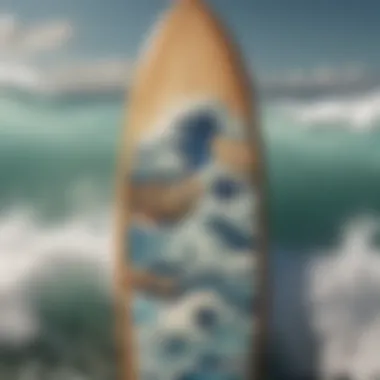
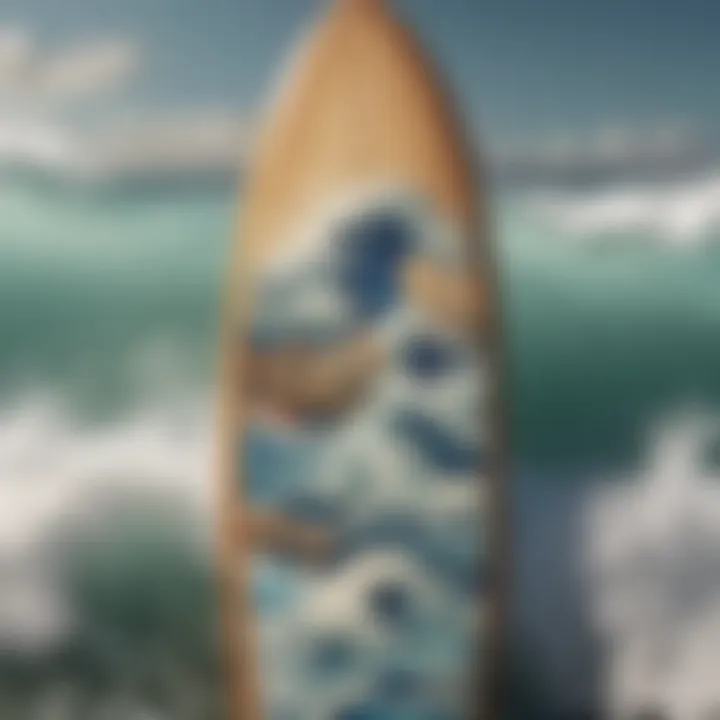
- Asymmetry: A unique feature of Japanese art is its asymmetrical composition which eschews perfection. Instead, it embraces imperfections to create a sense of naturalness. Surfers can relate to this—think about how no two waves are the same, each offering its unique challenge and beauty.
- Negative Space: The use of negative space enhances the elements within the composition, allowing the viewer to breathe visually. Similarly, surfers must learn to read the ocean's subtle cues between waves, understanding the significance of calm waters in the midst of surf.
- Focus: The principal focus often lies on a single subject, with surrounding elements supporting, but not detracting from it. This principle is akin to the surfer’s attention to their board, their movement, and the rhythm of the waves.
To encapsulate these ideas, we can say that the composition and balance in Japanese art mirror the surfer’s journey: seeking stability amidst the unpredictable forces of nature.
Color Usage and Emotion
Color usage in Japanese art is not merely decorative; it conveys emotion and meaning. The choice of colors can evoke a range of feelings, from calmness to tumult, which resonates with the surfer’s experience of the ocean.
- Palette Variations: For example, hues such as deep indigos and vibrant blues are prevalent in wave art, symbolizing the depth and vastness of the sea. Surfing enthusiasts often describe the ocean’s rich blue tones as calming, connecting them to the tranquil side of the sport.
- Emotional Impact: Bright colors can represent joy or energy, much like the exhilaration found in riding big waves. Conversely, darker tones might reflect the unpredictability of a stormy session, resonating with the surfer’s respect for the ocean’s might.
- Cultural Influences: The palette in Japanese art carries cultural significance too. Traditional colors often relate to natural elements, lending an authenticity that links surfers back to the very essence of what they ride—the waves.
"Color is the keyboard, the eyes are the harmonies, the soul is the piano with many strings."
--Wassily Kandinsky
Both surf culture and Japanese art draw on emotional interpretations of their environments. The artistic use of color enhances understanding of a surfer's mental state, their exhilaration on a perfect wave, or the meditative calm after a long day's ride.
The Symbolism of Waves
The significance of waves extends far beyond the surf and sea; they embody a range of thoughts, emotions, and values deeply rooted in both Japanese art and the culture surrounding surfing. Waves serve as powerful symbols in artistic expressions, where they reflect the duality of nature's awe-inspiring beauty and its potential for turbulence. Such representations resonate with surfers not only as a source of joy but also as a profound metaphor for life's challenges and triumphs.
Cultural Interpretations of Waves
In Japanese culture, waves are often seen as manifestations of the transient nature of existence. They symbolize the ceaseless ebb and flow of life, much like the tides themselves. Traditional art pieces, particularly those influenced by Japanese woodblock prints, capture the dynamic movement of waves, illustrating their unpredictability and strength.
Waves are also associated with various spiritual meanings. In Shinto beliefs, they are regarded as emissaries of the gods, while in Zen Buddhism, the fluidity exemplified by waves speaks to the concept of impermanence—reminding individuals to embrace change rather than resist it. For instance, the iconic Great Wave off Kanagawa by Hokusai not only mesmerizes with its aesthetic beauty but also invites reflection on nature's might.
Moreover, the cultural significance of waves transcends boundaries, becoming a universal symbol of freedom and adventure, essential elements within surf culture. Surfers view the ocean as a playground, and each wave presents an opportunity for self-expression and connection to nature’s rhythm.
Waves as Metaphors in Surfing
In the world of surfing, waves serve as potent metaphors that encapsulate more than just physical challenges; they represent personal journeys and the pursuit of conquering one’s fears. For many surfers, riding the waves is akin to navigating life's complexities, where each swell symbolizes new challenges and victories.
The act of surfing itself becomes a form of meditation, offering a sense of clarity and purpose. The unpredictable nature of waves mirrors the unpredictability of life. Just as surfers must read the ocean's movements and adjust their approach, individuals in their personal lives often find themselves adapting to unforeseen circumstances, learning, growing, and rising with each wave.
- Connection to Nature: Surfing fosters a deep connection to the natural world, as riders become attuned to the ocean’s rhythm, perceiving each wave as an invitation to engage with the environment.
- Pushing Boundaries: Surfers constantly test their limits, with challenging waves representing obstacles that demand resilience and perseverance—qualities that transcend sport and apply to everyday life.
Ultimately, the symbolism of waves encapsulates a shared experience among surfers, binding them through a common understanding of struggle, joy, and the pursuit of freedom on the ever-changing ocean.
Through aesthetics, spirituality, and experience, the symbolism of waves significantly enriches not only the narrative of Japanese art but also the identity of surf culture itself. Each wave tells a story—of nature, of life, and of the surf community that seeks solace and thrill among them.
Cross-Cultural Influences
The connection between Japanese art and surf culture is more than a mere aesthetic overlay; it delves deep into how cultures shape and redefine each other. Understanding this cross-cultural influence is essential in appreciating the intricate tapestry of traditions, beliefs, and practices that mold the identity of modern surfers.
Japanese Art in Western Perception
Japanese art has often been viewed through a Western lens, which many times emphasizes the visual and emotional impact of its components, particularly the wave imagery. Artists like Katsushika Hokusai have painted not just waves but culturally rich symbols that resonate with broader themes of nature, humanity, and transience.
In the West, pieces like Hokusai’s "The Great Wave off Kanagawa" are iconic for their visual allure but are also appreciated for their deeper philosophical undertones. This image portrays not just a natural phenomenon but also reflects a struggle—where man meets nature, showcasing the awe and fear that coexist in an oceanic environment. For surfers, it’s a reminder of the power of the ocean; the wave encapsulates both beauty and risk.
Through exhibitions and publications, Western audiences have come to embrace not only the art but the cultural significance behind it. The appropriation of traditional motifs into various modern art forms has elevated Japanese art beyond its geographic confines. Furthermore, discussions on platforms like Reddit have connected enthusiasts with a newfound appreciation for these historical narratives, blending them with contemporary movements.
“Art is a portal. It allows us to appreciate the culture of another while enabling us to reflect on our own space within it.”
Fusion in Surf Culture
Surf culture is an intriguing fusion of global influences, with Japanese aesthetics finding a niche within its framework. The integration of wave imagery into surfboard designs has become a canvas for artistic expression, connecting both history and modernity.
- Stylized Graphics: Many surfboards today are not just sporting equipment; they’re works of art. Artists draw inspiration from traditional Japanese prints to create graphic designs that echo the turbulent yet beautiful nature of waves.
- Cultural festivals: Events celebrating surf culture often integrate elements of Japanese tradition, such as Taiko drumming and Irezumi tattoos, celebrating the connection of water and art in an immersive experience.
- Sustainability movements: As surfers become more environmentally conscious, many look to the balance found in Japanese aesthetics—achieving harmony with nature while embracing craftsmanship that respects the ocean.
In this blend, the symbolic imagery of waves transforms the way surfers perceive their sport. It transcends being merely a recreational activity; it becomes a shared choice, representing communal values of respect, collaboration, and a deep connection to the ocean.
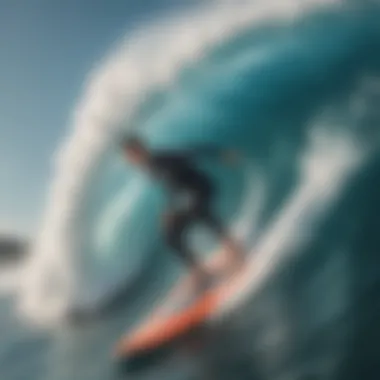
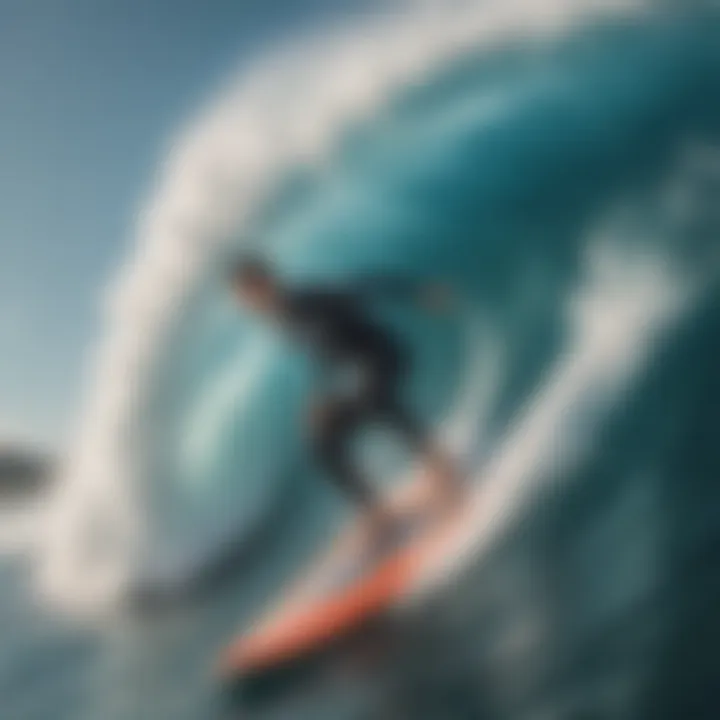
The art of surfing is no longer segregated from its cultural roots. Instead, it has evolved to reflect a complex interplay of influences that highlight the surf community's continuous dialogue with art, nature, and tradition.
This tapestry of cross-cultural influences encourages both surfers and artists alike to reflect on their heritage while exploring new narratives shaped by the ocean’s waves.
The Impact on Surfboard Design
The intricate dance between art and surf culture is striking, especially when one considers surfboard design. In addition to being a vehicle for riding waves, surfboards have evolved into artistic canvases where vivid graphics and timeless aesthetics collide. This section investigates how the influence of traditional Japanese wave art shapes surfboard design, addressing several pivotal aspects that contribute to this remarkable interplay.
Artistic Influences on Surfboard Graphics
Surfboards adorned with captivating visuals often tell a story, and in many cases, these narratives pull inspiration directly from Japanese artistry. Imagine the stunning imagery of Hokusai's waves, bold and sweeping, splashed across a board's surface. These graphics do more than just catch the eye; they bridge the gap between oceanic exploration and cultural heritage.
Consider the following highlights of this influence:
- Motifs and Themes: Many contemporary surfboard artists incorporate traditional motifs, such as waves, fish, and other natural elements rooted in Japanese art. This not only honors the historical context but also creates a connection to the ocean.
- Color Palettes: The use of color in Japanese art often reflects the atmosphere and mood of the ocean. Designers use these palettes to evoke feelings of tranquility or exhilaration, paralleling the surfers' emotional experiences.
- Techniques: Techniques used in Japanese woodblock prints, like Ukiyo-e, inspire many surf artists. This can be seen in the layering of colors and textures, providing a depth that adds an extra dimension to surfboard graphics.
Engaging these themes in surfboard design, artists ensure that each board is not just functional, but also an homage to a rich artistic tradition. As these boards hit the waves, they carry with them stories—of culture, history, and the shared love of the ocean.
Craftsmanship Inspired by Tradition
Craftsmanship in surfboard design draws extensively from the revered techniques rooted in Japanese culture. The meticulous approach seen in traditional woodwork and artistry influences modern shapers in various ways, raising the stakes for quality and aesthetics alike.
In this realm, several key factors emerge:
- Material Choices: The selection of materials reflects a deep respect for nature. Similar to traditional Japanese artisans who prioritize natural materials, modern surfboard builders are inclined to choose sustainable woods and eco-friendly resins that honor the earth—a crucial consideration given the oceanic environment they navigate.
- Precision and Detail: Japanese craftsmanship is known for its attention to detail. Whether it’s in the smooth contours of a board or the intricate artwork, this standard leads to higher-quality surfboards that not only perform well but also look exquisite.
- Balance and Harmony: There’s a fundamental philosophy in Japanese art that emphasizes balance and harmony. This philosophy permeates surfboard design, influencing elements like the shape and length, ensuring that each piece rides the waves gracefully while maintaining visual appeal.
"The beauty of a surfboard transcends its utility; it embodies the very essence of the waves it rides."
As surf culture continues to evolve and merge with traditional influences, these artistic and craftsmanship principles are pivotal in enriching the experiences of surfers. They find not only a functional piece of equipment but also a reflection of their identity and an expression of art—woven into a harmonious whole.
Crafting a surfboard becomes not merely an act of production; it transforms into a celebration of cultural fusion that honors a legacy, reminding surfers that every wave ridden is steeped in artistry.
Environmental Reflections in Japanese Art
Japanese art, especially the celebrated representations of waves, highlights a unique relationship between humankind and nature. As surfers seek a deeper connection to the ocean, these artistic reflections offer insights into how this relationship has been depicted across centuries. The confluence of artistry and environmental awareness in Japanese culture reveals a profound understanding of nature’s chaotic beauty, its elongated rhythms, and dynamic transformations.
Japanese artwork, particularly influenced by the natural world, captures the essence of environmental consciousness long before it became a modern rallying point. Artists like Katsushika Hokusai didn't merely illustrate the ocean's waves; he infused them with emotion and significance, reminding viewers of their power and the delicate balance in nature that they represent. In this way, each artistic depiction serves a dual purpose: celebrating the beauty of the waves while simultaneously urging respect and contemplation of their inherently volatile nature.
Nature’s Role in Art
Nature acts as the canvas for much of Japanese art. From serene landscapes to tempestuous waves, artists draw inspiration from their surroundings, often mirroring the unpredictability of the elements. This relationship can be traced back to ancient times when the philosophies of Shintoism and Buddhism emphasized harmony with the natural world.
- Representation: Traditional Japanese paintings often focus on elements such as wind, water, and earth. The sweeping lines of a wave, for instance, don’t simply represent water, but rather depict the lifeblood of the ocean, feeding the ideas surrounding sustainability and respect for the ecosystem.
- Philosophical Roots: The philosophies embedded in these artworks extend to the present, forming a core part of the cultural consciousness. The idea that humanity is but a small part of nature is reinforced through artistic expression.
- Contemporary Resonance: Modern surfers often find their identities shaped by these concepts. The challenge of riding a wave echoes the trials of navigating nature itself—an experience mirrored in Hokusai’s splashes of blue and white which capture the intense force of water and its influence on life.
"In every brush stroke, an echo of the waves whispers, urging respect for the tides and the art of navigating life’s ebbs and flows.”
Surf Culture's Eco-Consciousness
As surf culture evolves, it increasingly reflects eco-consciousness rooted in both traditional Japanese principles and contemporary environmental movements. Waves become not just a playground but a symbol of nature’s fragility and resilience.
- Awareness: Many surfers today recognize the impact of their sport on the environment. This heightened awareness ranges from understanding ocean currents to minimising pollution on beaches. Artists within this culture are influenced directly by their relationship with the ocean, prompting them to create works that emphasize sustainability.
- Cultural Synthesis: The melding of artistic influence from Japanese wave art and modern environmental ethics offers a new foundation for surfing practices. Decks of surfboards might now feature intricate designs inspired by famous artworks, serving as a reminder of the sea’s heritage.
- Future Directions: The future of surfing is increasingly entwined with eco-conscious initiatives. From using sustainable materials in surfboard production to participating in ocean clean-up projects, today’s surfers are paving a new path that honors both the ocean and the artistic traditions that celebrate it.
Psychological Aspects of Surfing and Art
The interplay between surfing and art encompasses not just physical expression, but also a profound psychological experience. In this section, we explore the layers of psychological benefits derived from the merging of these two realms. This relationship speaks volumes about the way surfers connect with not just the ocean, but also with artistic representations of that environment. By understanding the psychological aspects, we can appreciate how such connections forge deeper attachments to surfing, artistic expression, and identity.
The Meditative Experience of Surfing
Surfing is often described as a meditative endeavor. When a surfer paddles out, there exists a shift in awareness—a moment when everything slows down. It’s almost as if time has taken a backseat. As the waves roll in, the focus narrows; the swirling waters become akin to a rhythmic mantra.
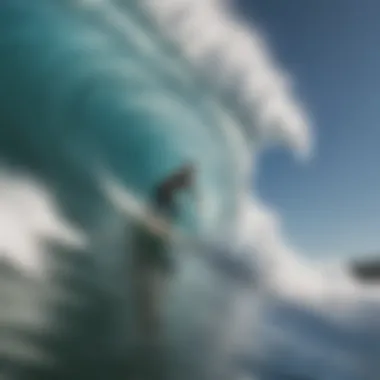
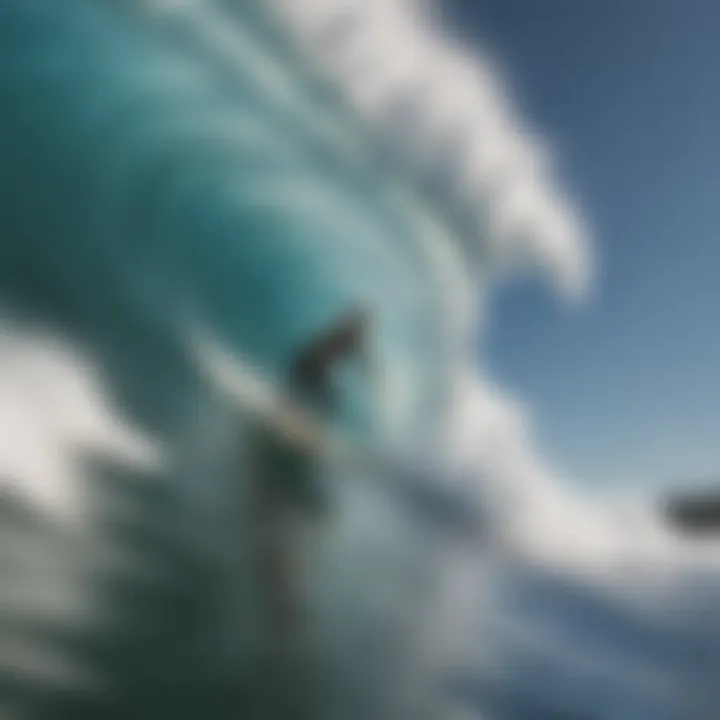
Surfers frequently report a feeling of being in the 'zone', a state of flow where clarity reigns. This experience aligns closely with the principles of mindfulness. Much like traditional meditative practices, surfing requires a harmonious balance between mind and body. The physical demands of riding a wave compel one to be present, to engage fully with the moment, fostering a sense of peace and contentment.
Researchers note that such meditative states can enhance mental health, reducing stress and anxiety levels significantly. Moreover, engaging in something as dynamic and visceral as surfing can invigorate one's spirit. It creates a unique cocktail of adrenaline and tranquility. Add in the influence of Japanese art’s representation of waves—a symbol of both power and beauty—and one begins to understand how art influences this meditative experience even further.
Artistic Expression and Identity
Artistic expression in surfing goes beyond mere aesthetics; it embodies the identity of surfers. The act of painting a surfboard, capturing a wave’s essence through brush strokes, allows surfers to convey personal narratives. In many ways, the design becomes a part of their identity, just as much as their style on the waves.
The Role of Cultural Heritage
Japanese wave art, with its dynamic lines and fluidity, carries a rich cultural heritage. It expresses emotions of struggle, resilience, and harmony with nature. Both surfing and this traditional art form share an innate connection to the ocean, serving as a meditative symbol. Integrating this art into surf culture not only enhances aesthetic appeal but also elevates a surfer’s sense of self, merging cultural appreciation with personal identity.
- The unique identity is forged through common touchpoints between art and surf culture.
- There’s a community-driven element where surfers often band together to share and celebrate in the expression of these waves—and therein lies the beauty of collaboration.
It’s no surprise that many surfers have chosen to adopt the wave motifs from Japanese art, using them to symbolize their journey, aspirations, and lives spent in the surf. Through these artistic expressions, surfers communicate their individual stories while simultaneously respecting the broader cultural narratives that resonate with their experiences.
"Surfing is not just a sport; it's a connection to art, history, and personal identity that flows through the waves and the canvas alike."
In essence, the psychological aspects of surfing, when combined with the influences of art, shape a complex tapestry of human experience. This journey offers surfers not just physical exhilaration but a pathway to exploration and self-discovery. Understanding these intimate connections furthers our appreciation of both surfing and the art that reflects its spirit.
Modern Adaptations in Surfing
The intersection of traditional Japanese art and modern surf culture is not just a fleeting trend; it embodies a profound dialogue between two realms that seemingly run parallel. For surfers, there's a deep, instinctual pull toward the ocean, and when they encounter waves illustrated in bold strokes on their boards or in galleries, it resonates with something primal. This section will explore how modern adaptations in surfing thrive on the intricate expressions found in iconic Japanese wave art.
The infusion of age-old artistic principles into surfboard designs and promotional materials transforms the way surfers engage with their environment. It also offers a rich tapestry of history and culture, allowing surfers to feel connected to decades of heritage. As many surfers are drawn not just to the act of riding the waves but to a lifestyle steeped in artistry and mindfulness, these adaptations become essential.
Contemporary Artists Inspired by Waves
There’s a wave of contemporary artists who have taken cues from classical Japanese masters like Hokusai, reinterpreting their themes for a modern setting. This fresh perspective often includes:
- Colorful interpretations: New artists often use vibrant colors to invoke the emotional highs found in the experience of surfing.
- Mixed Media: Artists are experimenting with combinations like resin and wood, reflecting the Elemental nature of both water and the earth, reminiscent of traditional Japanese techniques.
- Cultural Narratives: Many contemporary works resonate with personal stories tied to the sea, combining surf culture with narratives of Japanese heritage.
For example, artists like Takuji Kubo harness the essence of waves, creating prints that evoke the calm haze of early morning surfs along with the explosive energy of the ocean. Their art doesn’t merely decorate surfboards but tells a story, bridging the gap between artistry and an active lifestyle.
Emerging Trends in Surf Art
As volleyball balls are to courts, surfboards are to the ocean. Yet, they’re far more than wood and resin. They are canvases for expression. Emerging trends in surf art reveal a fascinating evolution, reflecting contemporary influences while nodding to traditional practices. Some potent trends include:
- Sustainable Art: As awareness grows around environmental issues, artists increasingly use eco-friendly materials and practices. This mirrors the eco-consciousness prevalent in today’s surfing community.
- Digital Designs: With technology on the rise, digital media has become an avenue for artists to experiment with designs that can be instantly shared or printed on demand. This openness brings a unique flavor to graphic surf art.
- Collaborations: It’s not unusual to see artists partner with surfboard manufacturers, creating limited edition boards that meld functionality with artistry.
As said in traditional Japanese culture, “To ride the waves is to live with purpose.” This ethos underlines the modern adaptations, celebrating both the waves themselves and the culture around them.
Surfers today find themselves enveloped not just by the water, but by art that speaks to their soul. It’s at this crossroads where modern adaptations take flight, crafting a vibrant community that respects tradition while riding boldly into the future.
Epilogue: The Symbiosis of Art and Surfing
The intricate relationship between Japanese wave art and surfing culture showcases a remarkable blend of artistic influence, nature's beauty, and human experience. As explored throughout the article, waves serve not only as visual motifs but also as metaphysical bridges connecting centuries-old traditions with the modern pursuits of surfers. Understanding this symbiosis enhances both appreciation and practice within the surf community. The integration of art into surfing goes beyond aesthetics; it embodies a way of life, a shared language resonating with values such as adventure, respect for nature, and identity.
Reflection on Influence
When contemplating the impact of Japanese wave art on surf culture, several points stand out:
- Visual Language: The imagery of waves seen in traditional Japanese paintings like Hokusai’s The Great Wave off Kanagawa has transcended time and geography. Surfers see these waves not just as physical entities but as symbols of power, grace, and unpredictability, aligning perfectly with their own experiences in the ocean.
- Cultural Resonance: The motifs found in Japanese art echo the surfer's dialogue with the sea. Each wave depicted carries immense historical weight; they tell stories of nature's fury and elegance, reflecting the surfers' dance with the tides.
- Artistic Expression: The surfboards adorned with Japanese wave designs become canvases for personal expression. Each stroke and color choice transforms the surfboard into a storyteller of the ocean’s timeless narrative.
"Art gives the surfer a voice beyond the wave itself; it is a reflection of their deep bond with the ocean".
This connection illustrates how harkening back to traditional art forms can invigorate a contemporary practice, injecting depth and intentionality into surfing.
Final Thoughts on Cultural Integration
As we conclude the discussion, it's essential to consider the ongoing fusion of cultures. The influences of Japanese art are more than mere inspiration; they represent an evolving dialogue. The key takeaways here include:
- Mutual Respect: Surfing, deeply entrenched in nature, aligns with the Japanese cultural tenet of respect for the environment. Surfers who appreciate Japanese art often embody similar values, cherishing the ocean they ride on.
- Evolution of Aesthetics: The landscapes of surfboard graphics reflect a blend of modern sensibilities and traditional motifs. This melding contributes to the individuality of surfers, making each ride unique and personal.
- Community Building: The appreciation of this art fuels a communal identity among surfers, fostering discussions on heritage and the environment. This sense of connectedness builds stronger community ties, both among surfers and in appreciating broader cultural narratives.
In sum, the integration of Japanese wave art into surf culture paints a vivid picture. The ocean’s waves become not merely water but a canvas for life narratives, while art embodies a holistic appreciation of this connection. Surfers and artists stand together in a shared journey, pushing the boundaries of creativity and experience. Through this ongoing exchange, we see how the influence of art enriches the fabric of surf culture, crafting a narrative that is as profound as the oceans they ride.















